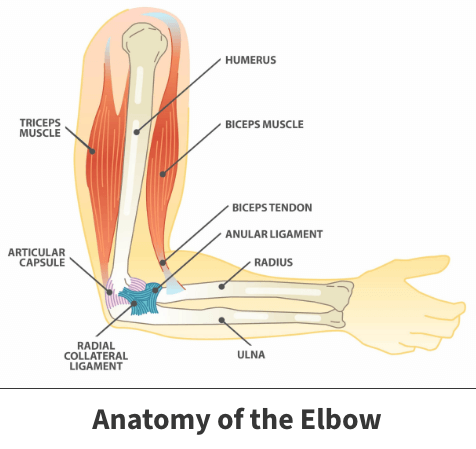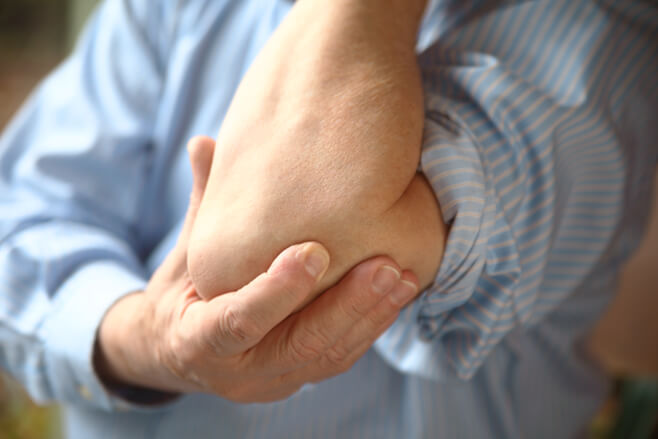Arthroscopic debridement of the elbow
Arthroscopic debridement of the elbow is a procedure used to look at the elbow joint using a small camera (arthroscope) and inspect, diagnose and repair any problems found. This procedure is an excellent alternative to regular surgeries since it involves a much smaller incision, resulting in a faster and easier recovery period. Recovery, although shorter than regular surgery, will still take several months and require physical therapy.
Anatomy

The elbow joint is where the upper arm bone (humerus) meets the two forearm bones (radius and ulna). The bony point of the elbow (olecranon) is at the upper end of the ulna.
The joint consists of several muscles, ligaments, nerves, and tendons, and is both a pivot and hinge joint, meaning it allows you to bend and straighten, as well as twist and rotate your arm. Thick ligaments (collateral ligaments), located on the inner and outer sides of the elbow, hold the joint together while preventing dislocation.
About
Arthroscopic debridement of the elbow is a procedure used to inspect, diagnose, and repair problems inside of the elbow joint. This procedure uses a small camera, called an arthroscope, which is inserted into the elbow. The camera allows for your Florida Orthopaedic Institute physician to use the arthroscope to look inside of the elbow without having to make a large incision.
The elbow may be a very complex and important joint, but it is not protected by muscle or fat like other joints, making it easier to injure. Damage to the elbow is usually caused by a traumatic injury, overuse from repetitive-motion tasks or sports, or from weakened bones due to aging. Arthroscopic debridement of the elbow may be necessary to confirm the presence of joint damage and remove unhealthy tendon tissue. Arthroscopy is considered an ideal treatment option since it requires smaller incisions, has shorter recovery times and less scarring than the surgical options.
Arthroscopic debridement of the elbow is only recommended if nonsurgical treatments such as rest, physical therapy, and medications or injections that can reduce inflammation have not been successful.
The most common injuries arthroscopic debridement of the elbow is used to treat include:
- Treatment of tennis elbow (lateral epicondylitis)
- Release of scar tissue to improve range of motion
- Treatment of osteoarthritis (wear and tear arthritis)
- Treatment of rheumatoid arthritis (inflammatory arthritis)
- Removal of loose bodies (loose cartilage and bone fragments)
- Treatment of osteochondritis dissecans (activity related damage to the capitellum part of the humerus seen in throwers or gymnasts)
Not all elbow injuries can be treated arthroscopically. There are several elbow surgical treatments that are most effective when done as an open, traditional procedure.

Surgical procedure
In preparation for this procedure, you will be positioned so that the elbow can be bent comfortably, and the area will be cleaned and sterilized to prevent infections. You will receive anesthesia to numb the arm and make you comfortable during the procedure. In some cases, general anesthesia is used instead of local anesthesia.
Your surgeon then creates a series of small incisions around the elbow, and inserts an arthroscopic camera as well as other tools necessary to complete the procedure. The camera allows your doctor to view the entire area of the elbow as the procedure is performed. Fluid is injected into the space around the elbow, which expands the joint, allowing your surgeon to look for any signs of damage or disease. Once the injury or condition has been discovered, the arthroscopic tools are used to repair any damage. At this point in the procedure, bone spurs may be filed down and loose, damaged cartilage will be removed.
Once the treatment is complete, the small incisions are closed with sutures. Finally, the elbow is bandaged, and you will be provided with medication for pain relief. Most patients are allowed to return home the same day.
Recovery
Although recovery from arthroscopy is often faster than recovery from open surgery, it may still take weeks for your elbow joint to completely recover. You can expect some pain and discomfort for at least a week after surgery. If you have had more extensive surgery, it may take several weeks before your pain subsides. It is important to ice and elevate your elbow regularly for 48 hours after surgery. This reduces the risk of severe swelling and helps to relieve pain. Depending on the type of surgery performed, your Florida Orthopaedic Institute physician may recommend specific instructions for longer periods of ice and elevation.
Rehabilitation plays a vital role in getting you back to your daily activities. An exercise program will help you regain elbow and forearm motion and strength. Your Florida Orthopaedic Institute physician will develop a rehabilitation plan specifically designed for you. The time it takes for you to return to daily activities depends on the type of surgery and will be discussed with you before your surgery. Full recovery may take several months.
Videos
Related specialties
- Aspiration of the Olecranon Bursa
- Cubital Tunnel Syndrome
- Elbow Bursitis
- Elbow Injuries & Inner Elbow Pain in Throwing Athletes
- Golfer's Elbow
- Growth Plate Injuries of the Elbow
- Hyperextension Injury of the Elbow
- Little Leaguer's Elbow (Medial Apophysitis)
- Olecranon Stress Fractures
- Radial Tunnel Syndrome
- Tennis Elbow Treatment
- Tricep Pain & Tendonitis
- UCL (Ulnar Collateral Ligament) Injuries
- Valgus Extension Overload
